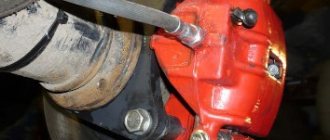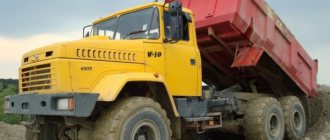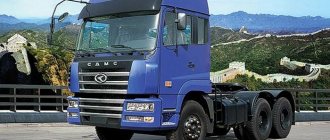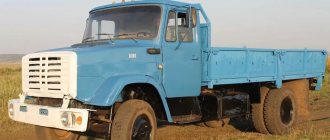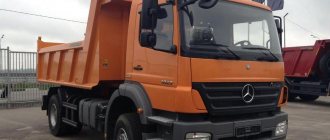Sergey Egorov Photos from the author’s archive and from the sites www.dpdproductions.com, www.aeroimage.com and www.siloworld.net
Since the advent of intercontinental ballistic missiles (ICBMs) in the USSR and the USA, the armies of both countries have required special automotive equipment for their transportation and maintenance. In our country, the newly formed Strategic Missile Forces initiated the creation of unique multi-axle all-wheel drive vehicles for special purposes. Information about some of them was classified as “secret” for a long time. Over the past two decades, more has become known about the USSR missile forces and special equipment. What kind of cars did our Cold War opponents have? In the field of motor transport support, US rocket scientists went their own way.
First call
The competition between designers of the USSR and the USA in the field of military rocketry began immediately after the end of World War II, and by the end of the 1950s. the military of both countries received combat-ready ICBMs. In 1959, the first 6 Atlas D missiles of the so-called one and a half stage configuration entered service with the US Air Force. In 1962, the strategic forces already included 142 Atlas missiles of modifications D, E and F, manufactured by the Convair department of the General Dynamic corporation. The first generation rockets ran on liquid fuel and were refueled only before launch, which was carried out from stationary complexes of various types. In its “dry” form, the Atlas D rocket, with a length of 23 m, weighed no more than 7 tons with a take-off weight of 118 tons. However, this weight level was achieved by using thin-walled fuel tanks with minimal use of the power set, and so that the rocket did not crumple under its own weight during transportation Nitrogen was pumped into its tanks under pressure. Each rocket was equipped with a low-loading two-axle semi-trailer manufactured by Goodyear Aircraft Corp. (the aviation department of a well-known tire manufacturer), which served as a pallet for storing the missile and transporting it on C-133 military transport aircraft. Early-model trailers weighing 10.1 tons for the Atlas D rocket also served to lift it to a vertical position at the launch position. At the end of 1959, semi-trailers with steering wheels and two steering cabins on the sides in front of the axles appeared, which were used to transport missiles of all modifications.
At first, they were used to work with both the standard 5-ton M52 (6x6) truck tractors available in the Air Force, produced according to a single specification by International Harvester, Diamond T and Mack, and commercial cabover vehicles International CO series (4x2), owned by Convair . M52 tractors were produced since 1951, they were equipped with Continental R6602-69 6-cylinder carburetor engines with a power of 196 hp. The gross vehicle weight on the highway could reach 20 tons with a seat load of 11.4 tons. Standard army vehicles in those years made up no more than a quarter of the entire military aviation fleet. In 1959, 94 Brockway 260LQM (6x4) 10-ton class commercial truck tractors with a 192-horsepower 6-cylinder Continental R6513 carburetor engine were supplied to the rocket launchers. Unlike other Air Force transport trucks, which were painted in dark blue "strata blue", the Brockways wore the yellow paint typical for airfield equipment. At air bases, Ford H-series two-axle long-haul truck tractors (produced in 1961–1966) were also used as tractors for Atlas missiles.
First generation missiles required a large amount of maintenance equipment, which was placed on semi-trailers. The complex included missile installers in a vertical position (used in silo-type positions), as well as containers for kerosene, liquid oxygen, nitrogen and helium. The described tractors could also work with this trailer.
In 1961, a more powerful Titan I intercontinental two-stage missile from Martin Aircraft Corporation entered service (63 units were delivered), which was much more convenient to transport. During transportation, its first and second stages were transported on two-axle low-loader trailers. The length of the trailer with the first stage was 13.6 m, its total weight was 8 tons. To tow the trailers, the same Brockway 260LQM tractors were used, but equipped with ballast. The final installation of the rocket took place at a silo-type position using a truck crane. The Atlas missiles of all modifications and the Titan I were finally withdrawn from service in 1965.
Bryansk: also problems
At BAZ there are also problems with personnel. Since November 2015, the company’s management has managed to change five times! In the fall of 2018, Alexey Sdobnov became the executive director of Bryansk Automobile Plant JSC, and new changes began. And with the position of chief designer after BAZ entered Almaz-Antey, there was a leapfrog. In December 2022 and... O. The chief designer (and then simply the chief designer) of the car plant was appointed a young promising specialist, Vadim Tarichko. Although he came to the plant relatively recently, he had time to join the team and fully understand all the processes taking place.
It has not yet been possible to reverse the negative trends in personnel issues at BAZ. The plant was looking for designers for key positions, but did not find them. Last year, Bryansk Automobile completely shook up the staffing of the design department. Someone left, some of those who left earlier came - in fact, little has changed. But some leading specialists who proposed sound ideas for the development of the plant and the development of new designs were reassigned to demoted positions.
This year, under the pretext of coronavirus infection, all designers over 65 years of age were fired from the BAZ. Veterans who did everything possible to ensure that the company participated in the development of a replacement for Minsk tractors were also fired. At a number of other defense industry enterprises, even during the period of the spread of coronavirus infection, no one had the thought of parting with experienced Soviet specialists. And young personnel are most often unable to work with veteran dedication.
There is no certainty yet that BAZ is interested in actively participating in work on chassis topics for the Strategic Missile Forces, although there are all the prerequisites for this. In November 2018, the powers of the sole executive body of the Bryansk Automobile Joint Stock Company (NWRC). Structurally, in the NWRC the role of the lead design team is assigned to JSC KBSM, which over the course of several decades has carried out many successful developments of ground equipment for the Strategic Missile Forces.
Why are the leaders of the Almaz-Antey concern and the SZRTs taking too sluggish actions and not actively promoting the involvement of BAZ in the work of replacing Minsk tractors? Or did the leaders of Almaz-Antey and Rostec (the main shareholder of KamAZ) divide their spheres of influence?
Half a century in office
All first-generation missiles had many disadvantages: they required bulky launch complexes, labor-intensive maintenance and refueling before launch, which is why their combat capabilities left much to be desired. As an alternative, since the late 1950s, Boeing has been developing a three-stage silo-based Minuteman rocket (Minutmen - militia soldiers of the Revolutionary War period of 1775-1783, ready to go into battle immediately upon receiving an order) with a solid fuel engine, more suitable for constant combat duty. However, the rocket stages filled with solid fuel at the manufacturing plant noticeably gained weight and required special vehicles for their transportation and installation in the silo. The first 20 Minuteman I missiles entered combat duty in 1962, and their mass delivery began the following year. The mass of the rocket was 29.5 tons with a length of 16.4 m.
At the same time, the aviators received new vehicles for their transportation and maintenance. The main vehicle for the technical support of Minuteman missiles was a transporter-installer, consisting of an 8x4 tractor and a three-axle semi-trailer with a lifting container for transporting the missile and installing it in the silo. The first copy of the transporter was created in 1960. The project of this machine was developed by Boeing in parallel with the rocket, but its production was entrusted to other manufacturers. The tractors and semi-trailers were assembled by the cargo division of General Motors - GM Truck and Coach Division, the containers were assembled by the aircraft manufacturing company Cessna Aircraft, and the mechanisms for installing the rocket, consisting of a winch and a cable system, were assembled by Bendix. The length of the semi-trailer with the container was 19.5 m, width – 3 m, height – 4 m, which was close to the dimensions used in US road and rail transport. To reduce the size of the road train, the truck tractor had a reduced cabin height (only 1.83 m) and did not extend beyond the dimensions of the container. The total weight of the road train with the rocket was 49 tons. The tractor had an air suspension on all wheels and a lifting fifth-wheel coupling device, which made it possible to increase the degree of freedom of the road train when loading under its own power onto railway platforms along ramps. The power unit was a GMC 702 Twin-Six V12 carburetor engine with a displacement of 11.5 liters and a power of 275 hp. The tractor was equipped with a hydraulic pump to drive the semi-trailer equipment. The maximum speed was 64 km/h. After acceptance for supply, the tractor, according to the Air Force nomenclature, received the designation Truck Tractor, Transporter Erector A/S 32A-14, and the semi-trailer - Semitrailer, Transporter Erector A/M 32A-44.
Due to the fact that the rocket stages were assembled by different companies located far from each other, a whole technology was developed for their transportation and assembly. From the manufacturing plants, the stages were transported by road to Hill Air Force Base (Utah), where the finished rockets were assembled under the supervision of Boeing specialists. There they were loaded either into special air transportable containers or into transporter-installers and sent by air or rail to their deployment sites. From the nearest airfield or station, transporter-installers delivered the missiles to the combat duty site.
The arrival of a significant number of Minuteman missiles to the troops required an expansion of the Air Force fleet. In 1962, a batch of 390 long-wheelbase Ward LaFrance D-450-T (6x4) 15-ton class commercial truck tractors was purchased. The Ward LaFrance company from Elmira (New York) began to specialize in fire trucks in the 1950s. and the D-450-T models were one of the last trucks of this brand. In 1963, trucks disappeared from the company's production program. At the same time, a batch of Brockway 260 series (6x4) long-wheelbase truck tractors was purchased. Both types of tractors were used to work with special trailers, including three-axle semi-trailers for containers with Minuteman missiles during their unloading from a carriage or aircraft. Ward LaFrance tractors were also available at air force bases where Atlas missile systems were located.
Boeing, meanwhile, was developing an improved Minuteman II rocket, which had a take-off weight of 33.1 tons, and in 1963 introduced a program to convert transporter-installers. In order to increase the load-carrying capacity of the truck tractor and further comply with the road train, it was proposed to equip it with a fifth non-driving axle, as well as redesign the container design. Initially, plans included the conversion of 81 vehicles (perhaps this is the true number of transporters), but in 1965 (simultaneously with the adoption of the new missile for service), only 40 tractors were equipped with a fifth axle. The work on converting the tractors was carried out by the GM Truck and Coach department. The total weight of the modernized transporter-installer was 55 tons, and its load capacity was 36.3 tons. The load capacity reserve made it possible to use the conveyor for transporting Minuteman III missiles with a take-off weight of 35.4 tons, which entered service in 1970.
In 1966, to transport Minuteman missiles over long distances on highways, Goodyear Aerospace built several road trains consisting of a modified GMC F-series 8x4 commercial truck tractor and a three-axle box semi-trailer. The F-series tractors (1959–1968) had an angular aluminum cab just 1.2 m long, earning them the nickname “Crackerbox” from drivers, and were well suited to work as part of long and multi-unit road trains. The tractor and trailer were equipped with a very soft combined suspension, combining leaf springs, shock absorbers and pneumatic elements, as well as a system for maintaining the required humidity and temperature in the body. According to some reports, the tractor had the same engine as the installer transporters, since the well-balanced V12 engine created less vibration than diesel engines.
In 1989, the Loral aerospace corporation began production of new transporter-installers for Minuteman missiles, consisting of a five-axle tractor unit and a four-axle semi-trailer with a container. Despite significant design changes, the principle of installing a rocket in the silo remained the same. The tractors, designated A/S 32A-40, were built using the cab and units of the Peterbilt 362 commercial truck tractor, equipped with Cummins 450 hp diesel engines, as well as an auxiliary power unit to drive the equipment of the road train. The drive was carried out on three rear axles, which had air suspension. The now traditional silhouettes of a Minuteman fighter were applied to the cockpits of all vehicles. The total weight of the road train was 65.4 tons, length - 21 m. The maximum speed was limited to 80 km/h. The inside of the container was lined with heat-insulating material. The cost of the tractor was $1 million, and the A/M 32A-98 semi-trailer was one and a half times more. Replacement of the old type conveyors began in 1989, and in 1991 they were finally taken out of service. Some examples were lucky - they took places in open exhibitions on the territories of military air bases.
Another type of special equipment to support Minuteman missile systems was the so-called Payload Transporter, which was a covered 2-axle semi-trailer. They were used to transport and install warhead components on missiles, including nuclear warheads, as well as control and guidance systems. Since 1981, commercial Kenworth K100E 6x4 truck tractors with electric generator units mounted behind the cab have been used to operate them. It is noteworthy that tractors that had a high reputation among American truckers were chosen to deliver such important and dangerous cargo. One of the last deliveries of these transporters took place in 1993, when Martin Marietta manufactured 26 semi-trailers, designated Payload Transporter Type III, at a cost of $1 million each. The total weight of the semi-trailer with the tractor was 31 tons, the length of the road train was 20.1 m. The conveyor was placed above the head of the missile silo and, using a hoist, the components of the warheads were unloaded and installed through a hatch in the floor. On the sides of the body there were folding panels that protected the missile silo from atmospheric influences. Since 2003, Freightliner Argosy (6x4) truck tractors with a hoodless configuration have been used to tow transporters.
In addition to the listed special equipment, three-axle van semi-trailers are used at air bases, designed to deliver individual Minuteman III stages to the manufacturing plant to replace solid fuel that has expired. There are also 8-axle road trains for transporting entire missiles, which replaced the road trains manufactured by Goodyear Aerospace back in the 1960s. The fleet of special rolling stock is periodically updated. Thus, in 2008, the command of Hill Air Force Base entered into a three-year contract with Williamsen Manufacturing from nearby Salt Lake City for the development and production of special missile carrier semi-trailers.
In 2011, during one of the reports in the US Senate, information was announced about the beginning of the development of a new type of transporter-installers, as well as the arrival in 2015 of cargo transporters that provide better protection for transported goods.
Personnel collapse
At KamAZ, a team of SKShT specialists was created at an accelerated pace. But the bulk of the designers began work after the “Platform” research project was completed. Due to the rush during the implementation of the Platform-O design and development work, people worked virtually exhausted, specialists barely had time to complete the current work. Therefore, those who were hired in 2011, when the research and development work was already underway, had the opportunity to familiarize themselves with the results of the research work only in 2017.
After the completion of the Platform-O development work, by order of the Deputy General Director for Personnel Management and Organizational Development of KamAZ PJSC No. 348 dated August 3, 2022, all 70 employees subordinate to the chief designer for special wheeled chassis (GK SKSh) were redistributed to Scientific and Technical Center (STC) of KamAZ for newly created divisions. The latter have nothing to do with the development of military chassis-tractors. The goals of such an organizational structural change were declared: “1.1. Preservation and retention of highly qualified specialists from the departments of the chief designer of special wheeled chassis (hereinafter referred to as GC SKSh) in the Scientific and Technical Center. 1.2. Intensification of work within the framework of measures for import substitution of components and assemblies, reducing dependence on the supply of automotive components and components of foreign production.”
It was expected that as a result, the staff of highly qualified personnel in the departments of the chief designer of the SKSh in the Scientific and Technical Center would remain at a level of at least 90 percent. After the completion of Platform-O, as necessary, the designers carried out and continue to carry out tasks related to the development of promising SKShT. But the intensity of this work is not at all what it used to be.
Last spring, participants in the Platform-O development project were awarded. The author of the article has no information about what awards KamAZ executives received, probably the highest. In general, they tried to include the maximum number of managers who participated in the work of related enterprises and related organizations on the award lists. Evil tongues claim that many of those who have always been against the “Platform” also received awards. I believe there were no refusals of orders. Thus, the dissenters were silenced, so those involved in the work are now extremely reluctant to talk about shortcomings.
And they were hidden primarily in the vicious organization of work. It was not talented designers who were appointed to leadership positions, but so-called effective managers whose main goal was to use the allocated funds.
The reasons for the failure of the Platform-O design and development work were laid down already at the research stage. The lead contractor did not make comprehensive expert assessments - it was proposed to analyze the technical proposals at the stage of development work. One of the main mistakes is the actual implementation of research work within the framework of R&D, which is unacceptable. The practice of developing components in R&D to create final products has shown its inconsistency. Co-executors of the second level, who had the best technical solutions, but did not suit the top managers of KamAZ, were squeezed out by various methods. Conflicts arose in the relationship between the lead contractor and his partners, which were considered in arbitration courts.
It is no wonder that everything ended in failure and a tidy sum of government money was wasted. Over the past two years, there have been personnel changes in the leadership of the teams developing military SKShT.
In April last year, Alexander Shevchenko was appointed deputy general director of KamAZ PJSC for special projects. From November 1, 2019, Evgeny Makarov, who previously held the position of deputy chief designer for new developments of automotive units and special equipment, became the chief designer of KamAZ PJSC - director of the scientific and technical center (STC). Danis Valeev, who worked as the chief designer of KamAZ and director of the Scientific and Technical Center for almost a quarter of a century, was transferred to the position of adviser to the general director of KamAZ PJSC. The adviser to the general director of KamAZ, the head of the Platform R&D complex, Vladislav Polonsky, began to be gradually removed from management. Let me remind you that Colonel General Polonsky headed the Main Armored Directorate of the Ministry of Defense in 2004–2007, and Lieutenant General A. A. Shevchenko was the head of the GABTU in 2009–2019.
The management style at the KamAZ Scientific and Technical Center is changing; plant designers began to receive tasks on mathematical modeling of the design of promising SKShT. But the work manager is now extremely limited in terms of money. The reasons for the dwindling funding are clear: customers and co-executors are not satisfied with the results of the Platform R&D complex, so they fear history will repeat itself. The work is also slowed down by GABTU documents, which Alexander Shevchenko himself previously accepted. Now, being on the other side of the matter, he can no longer change them.
Peacemaker Service
In the early 1970s. Martin Marietta began designing a heavy solid-fuel ICBM, which was first given the designation MX (from Missile-eXperimental). The main feature of the rocket was the method of its launch - from a special container using the mortar (or “cold”) start method, in which it is ejected from the container due to the pressure created by the powder pressure accumulator. The rocket engine was started after the rocket exited. The MX carried 10 warheads, and its positions became a priority target for Soviet missiles. Because of this, in parallel with the development of ICBMs, various options for basing them were also considered. One of them provided for the placement of missiles on mobile ground launchers, which were supposed to move in a haphazard manner between shelters and, if necessary, launch.
Work on creating an experimental MX missile launcher on a wheeled chassis was started by Boeing Aerospace in April 1976. The launcher was a frame with a lifting missile container and outriggers, which was supported by two tractors. The launcher itself was manufactured by Boeing, and for the construction of tractors in September 1978, a contract was signed with Terex Division, a well-known manufacturer of mining dump trucks and earth-moving equipment.
The first of two tractors was built in July 1979. These 4-axle vehicles were created on the basis of the units of the Terex 33-11C mining tractor-coal truck, with drive only on the third axle and were equipped with a Detroit Diesel 16V-92TA diesel engine with a power of 1000 hp . In the fall of 1979, the launcher, designated Transporter Emplacer, was delivered to the Department of Energy test site in Nevada. This huge machine can be considered the world's largest wheeled vehicle: with a length of 50.4 m, a width of 6.6 m and a height of 9 m, the unit weighed 658 tons! The main task of its creation was to develop technical solutions when designing serial vehicles for similar purposes. In addition, a wide range of applied problems were studied, such as, for example, testing the terrain reference system and the ability of a road train to keep track. Tests that started in early 1980 showed that, thanks to automated systems, the rear tractor was able to follow the track left by the front one. After President Reagan in 1981 opted for basing MX missiles in silos, all work on the creation of mobile launchers was curtailed, and the Terex tractors and launcher were sold at auction without having managed to make a single launch. In 1990–1996 they were gradually dismantled and sold for scrap.
Meanwhile, work on the creation of the MX rocket was approaching its final stage, and the designers set about developing the technology for its transportation, since, according to established practice, each stage was manufactured by separate companies. The take-off weight of the MX was 88.5 tons with a length of 21.6 m. The main problem was transporting the first stage, 8.5 m long and weighing 49 tons, from the manufacturer to the rocket assembly site on public roads. For these purposes, in 1981, Goodyear Aerospace created a 5-axle, 40-wheel semi-trailer equipped with a container. All wheels of the semi-trailer were steerable, and its total weight was 86.3 tons. To work with it, Oshkosh created a truck tractor model K-2358 (6x6), equipped with a 6-cylinder Cummins KTA-600 diesel engine with a volume of 18.8 liters - the most powerful at that time an engine for road trucks. The vehicle, with a total weight of 36.8 tons, had air suspension and, as part of a 23 m long road train, reached speeds of up to 88 km/h. In total, 7 such tractors were produced in 1981.
The MX was first launched in 1983, and the first missile entered service in December 1986, designated LGM-118A Peacekeeper. Probably at the same time, transporters with Oshkosh tractors were transferred to supply the Air Force, while retaining their white color. A total of 50 LGM-118A missiles were built. Unlike the Mini, they were assembled right at the launch site. The stages were transferred from semi-trailers into shortened containers from Minuteman missile transporters and lowered into the shaft. In the first half of the 1990s. To help Oshkosh tractors, a batch of Marmon SB125R (6×4) commercial truck tractors in white paint was purchased. Marmon trucks were produced by Marmon Motor Company from 1964–1997. and were considered the most prestigious in the USA. The Peacekeeper missiles were retired in 2005, but some were converted into Minotaur IV missiles to launch military satellites. Their launch began in 2010 and is planned until 2013, and therefore at least one Oshkosh K-2358 tractor remains in service. Several cars of this type were previously written off and sold.
Domestic KamAZ tractors
The idea of switching to using our own equipment appeared a long time ago, at the very moment when tensions arose in relations with Belarus. To bring the idea to life, it was necessary to start everything literally from scratch. Russia did not have its own base for the production of such equipment, so it was mastered from the very beginning. The tender for production went to KamAZ , and since then active work has been carried out in this direction.
Several projects were developed for army needs. The largest of the tractors is the sixteen-wheel KamAZ-7850, designed to transport ballistic missiles up to 85 tons. The eight-wheel KamAZ-78504 truck tractor can haul a semi-trailer with a carrying capacity of 90 tons. The twelve-wheel KamAZ-78509, designed for installation of equipment, can carry up to 50 tons.
From the editor
The article was intended as a polemical response to V. Tuchkov’s article “Yars” with a Belarusian accent.” But in fact, A. Privalov confirmed the conclusions of our author. In the Russian Federation, production was destroyed and disorganized, qualified specialists were dispersed. But Alexander Lukashenko, no matter how you treat him, the Minsk Wheel Tractor Plant (MZKT), inherited from the USSR, has retained and has not lost its technology. And his management in industry turned out to be much better than the “defective management” in state corporations of the Russian Federation. The failure of the Platform-O project is a guarantee of this.
Alexander Privalov, editor-in-chief of the Automobile Catalog
Newspaper "Military-Industrial Courier", published in issue No. 32 (845) on August 25, 2022
